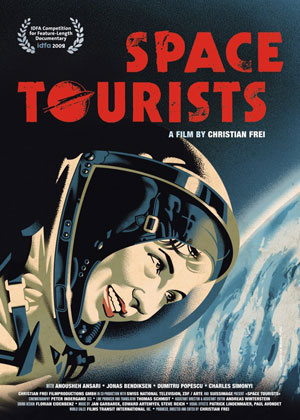Review: “Space Tourists” provides a rare glimpse of Kazakhstanby Ryan L. Kobrick
|
| Space Tourists makes many subtle points, but repetitive commentary on the financial need for commercial activities reaffirms a somber instead of exciting tone to the activities. |
The movie starts with helicopter footage of Anousheh returning to Earth with a violent retrorocket blast from her capsule on impact, a measure used to soften the landing on hard Kazakh terrain. The story then shifts back in time to focus on photographer Jonas Bendiksen’s journey to the former Soviet Union. As a space enthusiast in North America, this is where I really started to appreciate footage of old rocket parts randomly scattered in small towns, used in playground rides and in statues commemorating the proud and growing space industry. Statues of Sputnik and paintings on old brick buildings dilapidated over time set the tone of the movie, indicating that the collapse of the Soviet Union was also the collapse of the space program. Footage of Baikonur Cosmodrome was eerie as it reminded me of the historic and rusty launch pads at Cape Canaveral in Florida. Boarded up buildings near the Russian launch facilities in Kazakhstan where employees once lived gave a sense of how big an operation was in play during the Cold Wa,r and a rotting Buran (USSR’s space shuttle design, copying the USA’s Shuttle fleet) showed evidence of significant space program cutbacks.
Anousheh’s space mission wasn’t simply a tourist paying a lot of money to go to space, but she had a very profound and personal mission that wasn’t captured in the film. The film definitely uses Anousheh’s beautiful quotes from her experience, but the footage that was selected included mostly domestic chores and very little on the science that she was conducting. This selection was probably used to help contrast with another major part of this movie, the Kazakh scavengers of rockets. A secondary industry exists in Kazakhstan that I never thought existed. The documentary followed a group of metal salvagers on their journey to recover falling rocket stages that they fetch to sell the aluminum and titanium to China. This footage is so rare that it makes this movie a must-see for anyone in the space industry and anyone with an interest in cultural and historical impacts of space on small communities. Amazingly, portions of the second stages of the Soyuz rocket sometimes land in populated areas. The metals are sometimes considered a gift and they are used to repair holes in roofs—sometimes holes they created. The film also mentions concerns that the toxic propellants used in these stages may be adversely affecting the local environment.
| Overall the movie had excellent contrasts between life on the ISS and workers in Kazakhstan and how in some cases they depend on each other in a strange symbiotic relationship. |
Space Tourists makes many subtle points, but repetitive commentary on the financial need for commercial activities reaffirms a somber instead of exciting tone to the activities. The movie has additional stories of Microsoft Word & Excel’s chief architect Charles Simonyi training at Star City for his personal spaceflight while Anousheh is on the ISS. The movie then tries to look ahead at the future by following the former Ansari X PRIZE team Aeronautics and Cosmonautics Romanian Association (ARCA) during a balloon lift hardware test, and their intent to compete in the Google Lunar X PRIZE at the team summit that was held the International Space University. ARCA’s team lead and President, Dumitru Popescu, is passionate about space because “it’s fun” and that he is not that interested in being a “tourist” but wants to build his own hardware. Although the side story has cool footage and a personal look at ARCA, it wasn’t necessary for the story.
Overall the movie had excellent contrasts between life on the ISS and workers in Kazakhstan and how in some cases they depend on each other in a strange symbiotic relationship. Another movie highlight was the old Russian space folk music used in the background that showed how deep into the culture space had once penetrated. The story did jump around a lot and perhaps stretched out too much in some parts, but getting to see such unique and rare footage was fantastic.
The Soyuz is the most reliable and robust launch vehicle ever built and watching scenes of its integration made it seem very routine and safe. Watching the rocket roll out on a train track, get tilted upright, loaded and launched gave me an overwhelming feeling of how routine space was becoming. After all, it’s only rocket science!
